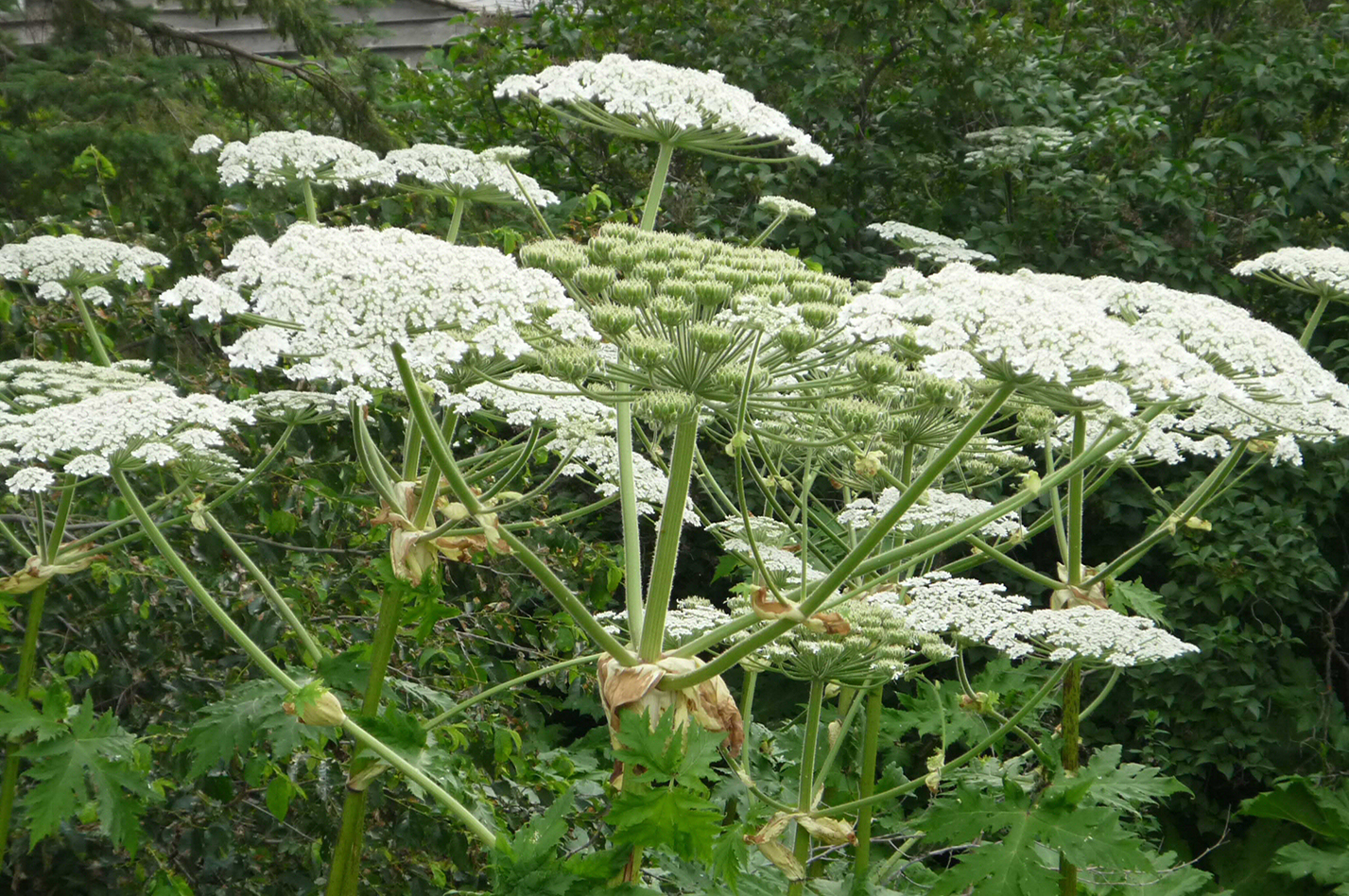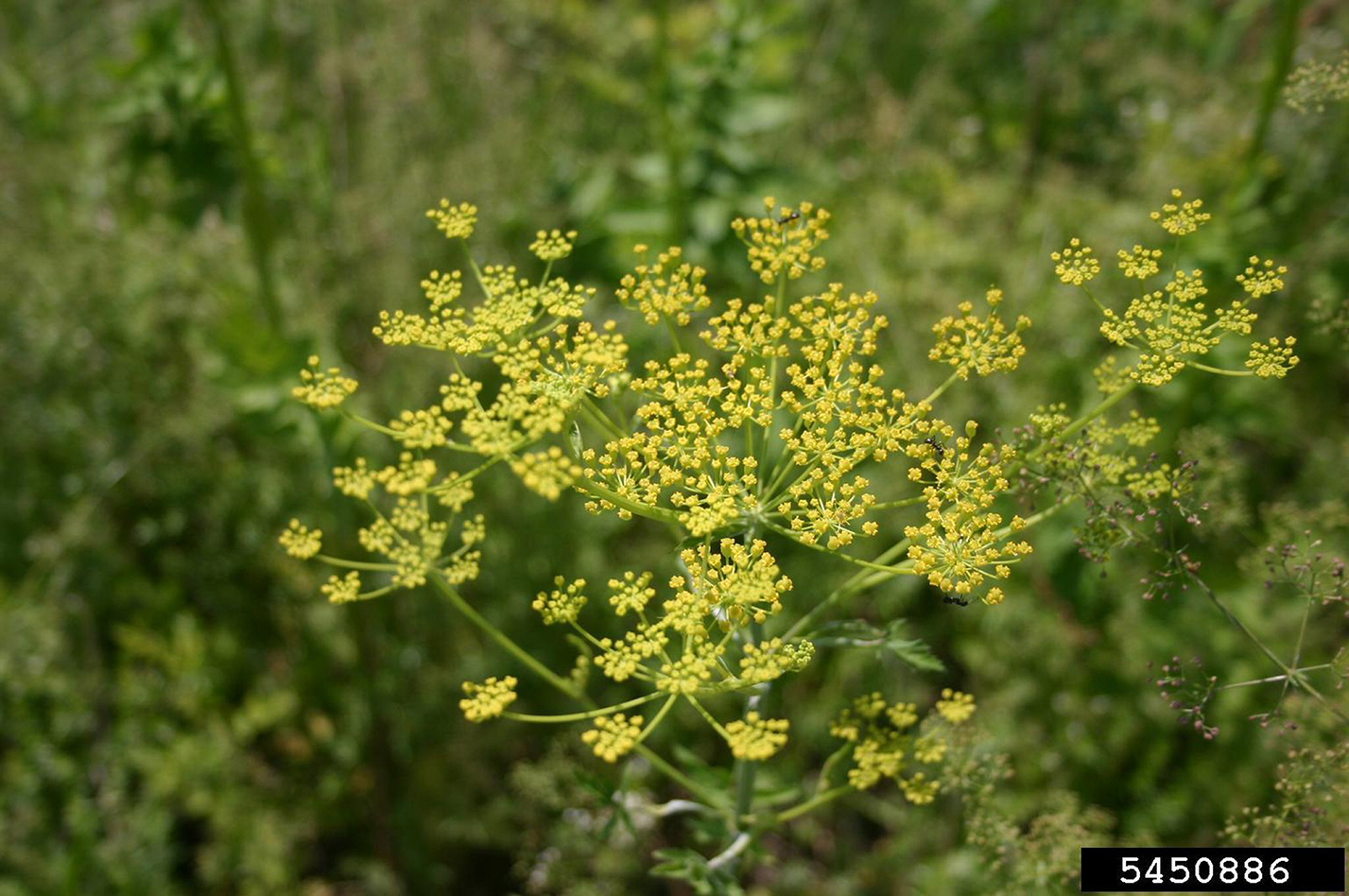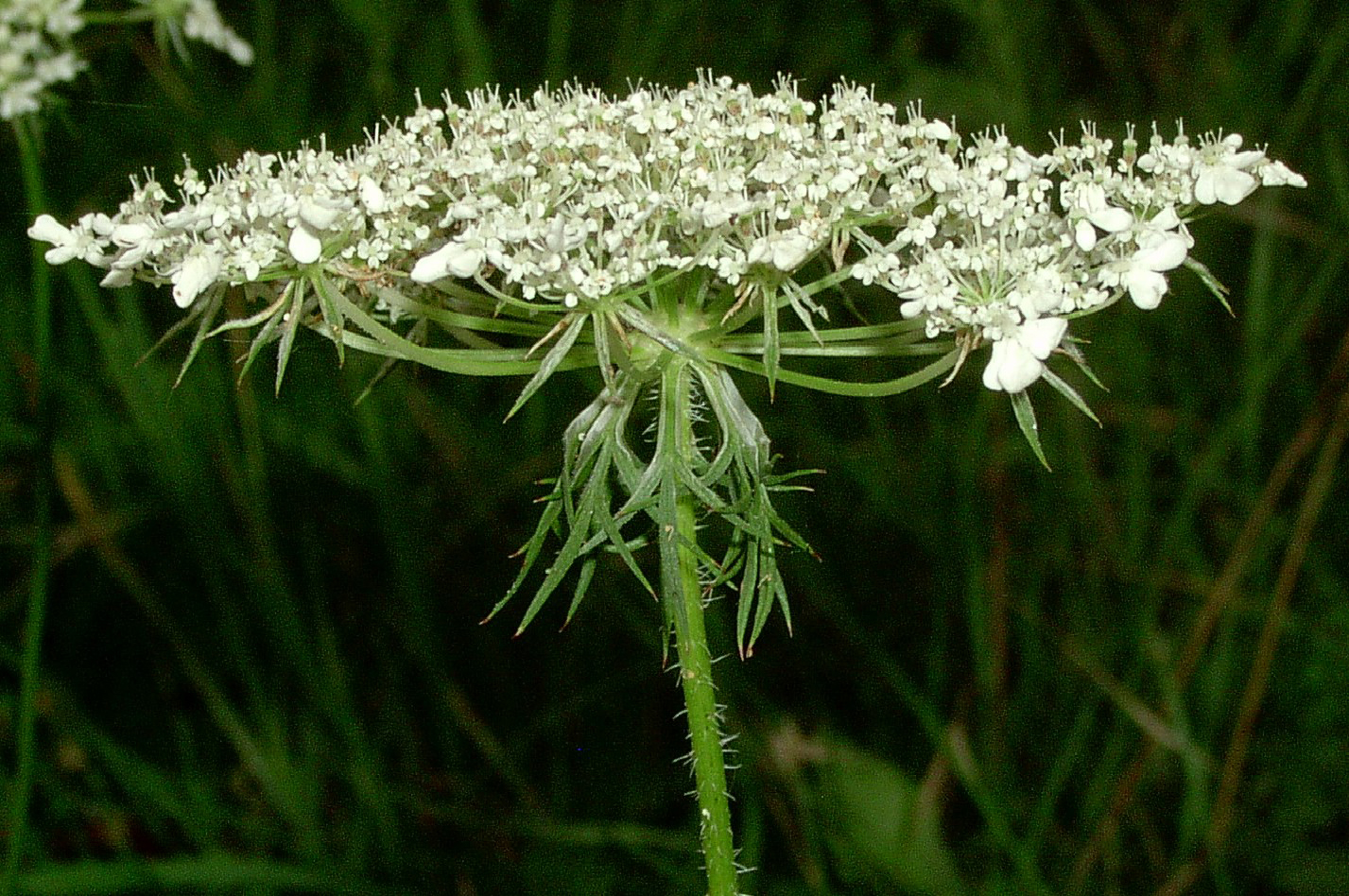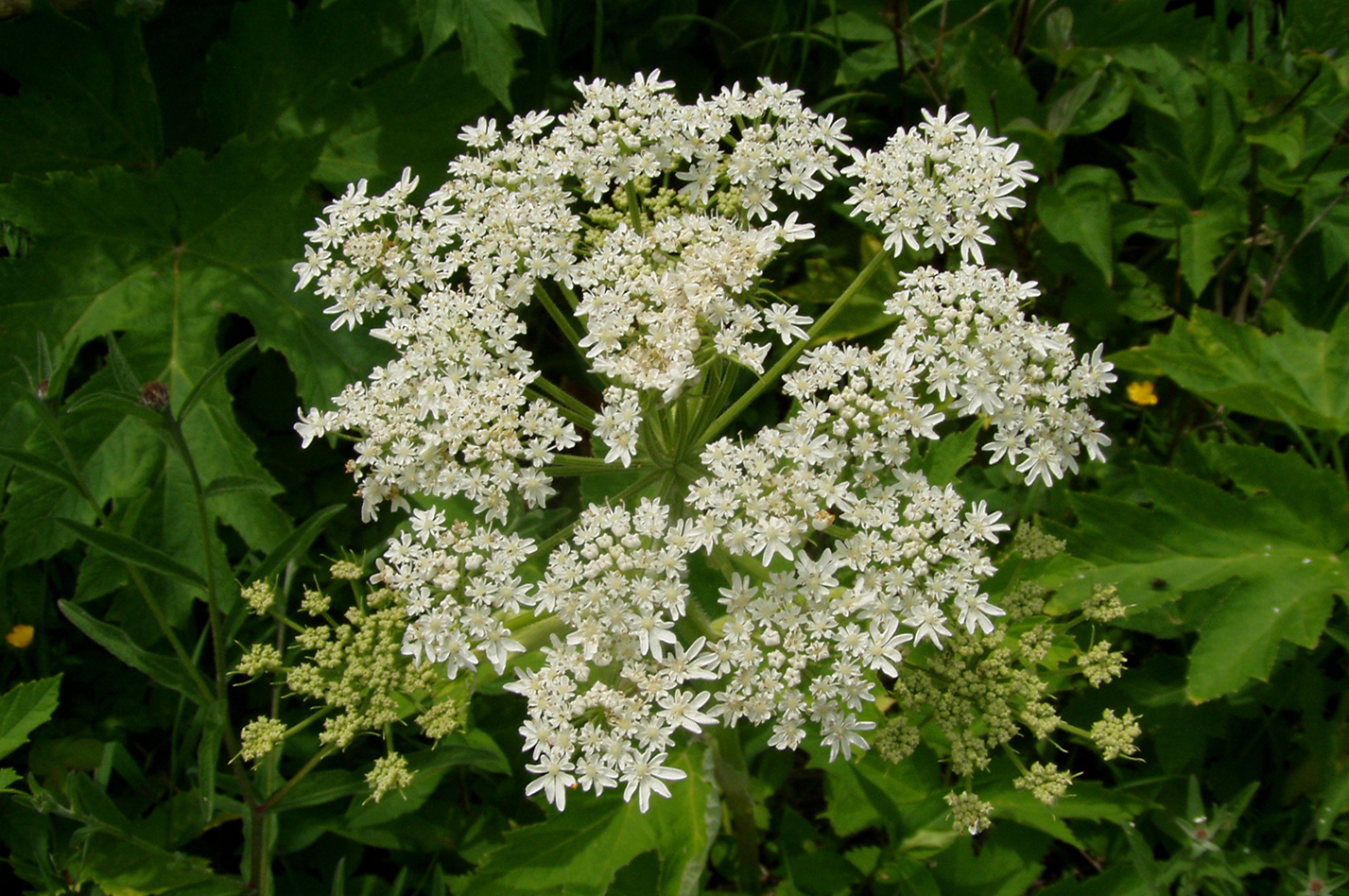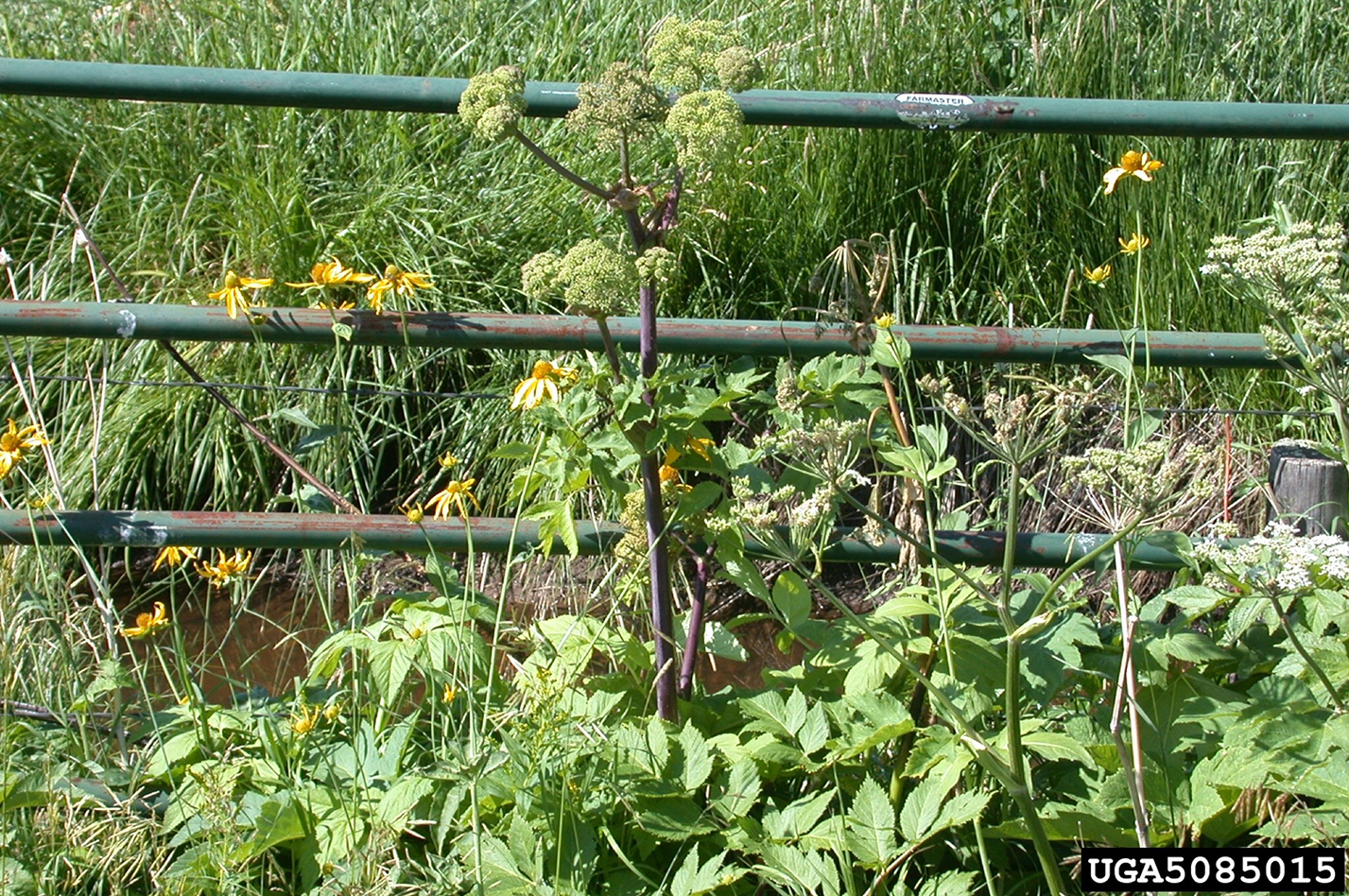Background
Giant Hogweed (Heracleum mantegazzianum) is a perennial plant and a member of the carrot family. It is a garden ornamental from southwest Asia that is naturalizing in North America and becoming more common in southern and central Ontario. Giant hogweed has the potential to spread readily and grows along roadsides, ditches and streams. It invades old fields and native habitats such as open woodlands.
Distribution
Giant hogweed has a scattered distribution across southern and central Ontario, south of the line from Manitoulin Island to Ottawa.
Biology
Seeds may take several years to germinate and are viable in the soil for up to 15 years. During the first year, the plant produces a rosette of leaves up to one metre high. After 2 to 5 years the plant produces flowers. As it grows a large root, thick hollow stems and large lobed leaves are formed. The stems of the plant are covered with reddish-purple flecks and stiff hairs filled with sap. Sap may also collect in the hollow stem bases. Giant hogweed flowers once in its lifetime, unless the flower clusters are damaged before opening. Once the plant produces seeds it dies. Each plant can produce up to 120,000 winged seeds (typically 50,000). Seeds dropped in streams can float for three days. They can move long distances via water in ditches and streams. Seeds can also be spread up to 10 metres by the wind.
Health Concerns
The clear watery sap of giant hogweed contains toxins that can cause severe dermatitis (inflammation of the skin). You can get severe burns if you get the sap on your skin and the skin is then exposed to sunlight. Symptoms occur within 48 hours and consist of painful blisters. Purplish scars may form that last for many years. Eye contact with the sap has been reported (in the media and by various web sites) to cause temporary or permanent blindness. However, evidence of permanent blindness linked to exposure to giant hogweed cannot be substantiated by any existing research. Coming in contact with cow parsnip and wild parsnip can cause similar reactions.
Natural Resources Impacts
There is evidence that giant hogweed can shade out native plants, although scientists have not done extensive research on its impact in Ontario or Canada. In the United Kingdom it grows in areas bordering lakes, streams, and wetlands and causes rocks, soil and other material on stream banks to fall into streams. This threatens salmon spawning sites. Similar impacts may occur in Ontario.
Prevention
Do not purchase, trade or grow giant hogweed in your garden. Only buy native or non-invasive garden plants. When you transport soil, sand or gravel make sure it is free of giant hogweed – both plant parts and seeds.
Removal and Management
If you have giant hogweed on your property, it is recommended that you hire a professional exterminator to remove it. The plant will be removed safely and as few seeds as possible will be spread. Reducing a large population of Giant hogweed will take a long term commitment. The guide to Best Management Practices for Giant Hogweed describes the most effective and environmentally safe control practices for this species.
The best time to remove the plant is in late April or early May. It is usually less than 30 centimetres tall, easier to dig up, and more susceptible to herbicides at this time of year. It is also cooler in the spring than in the summer so wearing protective clothing is more comfortable.
Protective clothing:
Wear protective clothing, including waterproof gloves, long sleeve shirts, pants, and eye protection. It is ideal to wear a disposable “spray suit” coverall over top of your normal clothing (spray suits are commercial grade waterproof coveralls). Remove protective clothing carefully to avoid transferring any sap from your clothing onto your skin. Wash your rubber gloves with soap and water, and then take off your spray suit or outer clothing. Wash your rubber gloves again and then take them off. Finally, take off your protective eye wear. Put non-disposable clothing in the laundry and wash yourself immediately with soap and water.
Mechanical control:
Spring Removal (i.e. early May):
Use a spade to remove as much of the root as possible. Digging up older plants can be difficult since roots can grow deeper than one metre. The plant might re-grow from the root and you may need to dig repeatedly to remove it completely. Or, you can cover the dug area with black plastic to smother out new growth. If it’s possible to use machinery, mow new growth every two weeks.
Summer Removal (i.e. early July):
- Plants without flowers: If the infestation is small dig the stems and roots out and dry them thoroughly before disposing of them.
- Plants with flowers: To prevent seeds from growing and spreading, remove flower heads before they ripen (when they are white). Note: If the flower heads have changed from white to green, seeds are being produced and it will be very hard to remove the seed heads and/or cut the plant without spreading the seeds. Return to the area regularly and remove any new growth.
Control Using Herbicides:
Herbicides can be used to control plants (like giant hogweed) that are poisonous to the touch. Glyphosate is effective at controlling the top-growth of giant hogweed. Foliar herbicide applications are most effective in spring on actively growing plants, followed with a subsequent summer application for missed plants or plants that have regrown. Since glyphosate is non-selective and removes only the green vegetation that it comes into contact with, new seedlings will often germinate and emerge after glyphosate has been applied. If areas treated with glyphosate are covered in mulch 10 to 14 days after application, it will reduce seedling germination and growth. Herbicide treatments may need to be repeated in following years. If a plant is flowering, herbicides are not effective and control methods should focus on carefully removing the flower heads. Follow label directions and relevant provincial and federal legislation when using herbicides.
Disposal:
Do Not Burn. Do Not Compost. Carefully remove flower heads from stems and place them in black plastic bags. Make sure not to drop any seeds while you are doing this. Seal the bags tightly and leave them in direct sunlight for about a week. Allow stems and roots to dry out thoroughly before disposing of them. Call your municipality to find out if bags containing Giant hogweed can be sent to your local municipal landfill site.
In the event of any direct exposure/contact to this plant; If you get sap on your skin wash the area well with soap and water. Keep the affected area out of the sun. If photo dermatitis (inflammation of the skin caused by exposure to sunlight) occurs, see a doctor.
If you get sap in your eye, flush your eye with water immediately and see a doctor immediately.
If you think you have giant hogweed on your property or if you see it in your community please call the Invading Species Hotline at 1-800-563-7711 or visit EDDMapS to report a sighting. You will be asked to send in photos for identification. Do not collect parts of the plant for identification.
The Ontario Ministries of Agriculture, Food and Rural Affairs, Health and Long Term Care, Environment, and Natural Resources and Forestry are working together with our partners (in particular Ontario Federation of Anglers and Hunters, Ontario Invasive Plant Council, Municipalities and Conservation Authorities) to provide information on the identification and control of giant hogweed.
Similar Species
There are a number of plants that look very similar to giant hogweed such as cow parsnip, Purplestem angelica, woodland angelica, valerian, lovage, and queen anne’s-lace (also known as wild carrot). However, these plants are not as large as a mature giant hogweed, which grows up to 5.5 metres tall under ideal conditions. The white flower clusters resemble those of queen anne’s-lace, but tend to be more widely spaced and can form a flower-head almost one metre wide.
INVASIVE
Giant Hogweed
(Heracleum mantegazzianum)
DETAILS
| Height: | 2.5 to 5 m |
| Flowers: | Large, white umbrella-shaped flower clusters 30 to 90 cm across, made up of 50 to 150 small flower clusters |
| Leaves: | Prominently spiked edges Up to 1.5m long Leaflets grow right out of each side of main stem, with no leaf stalk |
| Stem: | Hollow, 5 to 15 cm thick Prominent purple blotches Distinct, coarse, bristly hairs |
| Origin: | Biennial (lives for two years) or perennial (lives longer than two years) |
| Status: | Invasive |
INVASIVE
Wild Parsnip
(Pastinaca sativa)
DETAILS
| Height: | 0.5 to 1.5 m |
| Flowers: | Yellowish-green flower clusters 10 to 20 cm across |
| Leaves: | Leaves consist of 2 to 5 pairs of leaflets that grow across from each other along the stem, and one diamond-shaped leaflet on the end Leaflets toothed and often shaped like a mitten |
| Stem: | Green, 2.5 to 5 cm thick Smooth with few hairs |
| Origin: | Biennial/Perennial |
| Status: | Invasive |
NON-NATIVE
Queen Anne’s Lace
(Daucus carota)
DETAILS
| Height: | 0.3 to 1.5 m |
| Flowers: | White flower cluster 5 to 10 cm across. Pale pink before fully opened. Often single purple flower in centre of flower cluster |
| Leaves: | Leaves are staggered along the stem (alternate) Leaves consist of leaflets that are finely divided into narrow segments. Each segment of the lower leaves is further divided into fine lobes, resulting in a feathery appearance |
| Stem: | Green, 1 to 2.5 cm thick Covered with fine bristly hairs |
| Origin: | Biennial |
| Status: | Non-native |
NATIVE
Cow Parsnip
(Heracleum maximum)
DETAILS
| Height: | 1 to 2.5 m |
| Flowers: | White umbrella-shaped flower cluster 10 to 30 cm across, made up of 15 to 30 small clusters |
| Leaves: | Leaves have lobes shaped like a hand with fingers, with fuzzy undersides up to 0.5 m long and wide Leaf blade separated from main stem by leaf stalk |
| Stem: | Hollow, 5 cm thick at base Green, few to no purple spots Soft and fuzzy hairs |
| Origin: | Perennial |
| Status: | Native |
NATIVE
Angelica
(Angelica spp.)
DETAILS
| Height: | 1.2 to 2.1 m |
| Flowers: | Greenish-white globe-like flower clusters 8 to 25 cm across |
| Leaves: | Alternate leaves, divided into 2 to 3 leaflets |
| Stem: | Purple or purple blotched, Smooth (no hairs) |
| Origin: | Perennial |
| Status: | Native |
Gallery
OFAH/OMNRF Invading Species Awareness Program. (2021). Giant Hogweed. Retrieved from: www.invadingspecies.com.
This factsheet may be reproduced for non-commercial purposes.
Header photo by Ontario Federation of Anglers and Hunters

